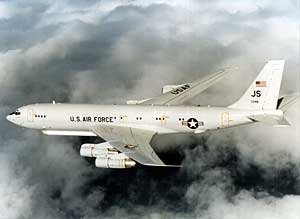The biggest problem facing the US military on the modern battlefield is command, control, and communications. Large ground-based communication systems are difficult to move and signals are limited by the curvature of the Earth and terrain features. The obvious solution are airborne command and control aircraft. This role was partially filled by the OV-10 Bronco, but that two-man aircraft was limited and thus retired by the Air Force and Marine Corps. The Army and Air Force developed the E-8C JSTARS for Corps-level operations (below). This is an outstanding aircraft, but extremely expensive to fly and must operate from large airbases. As a result, the Air Force has just sixteen JSTARS in service that cannot fill the need for 24-hour coverage for each division in combat.
 Modern ground forces need something
smaller and the answer is the Navy
E-2D Hawkeye airborne surveillance and
command-and-control platform. This durable aircraft can operate from aircraft carriers or
austere runways. Its economical engines burn 40% less fuel per mile than jets to allow up to six hours on station with a crew of five to
help coordinate
naval gunfire, artillery, close air support, local air defense, medivacs,
and combat search and rescue. More importantly, the Hawkeye can provide
clear, direct communications to ground forces and an automatic message relay
capability.
Modern ground forces need something
smaller and the answer is the Navy
E-2D Hawkeye airborne surveillance and
command-and-control platform. This durable aircraft can operate from aircraft carriers or
austere runways. Its economical engines burn 40% less fuel per mile than jets to allow up to six hours on station with a crew of five to
help coordinate
naval gunfire, artillery, close air support, local air defense, medivacs,
and combat search and rescue. More importantly, the Hawkeye can provide
clear, direct communications to ground forces and an automatic message relay
capability.
The newest Hawkeye variant, the E-2D is in production today and features extended radar range (40 percent greater than previous E-2C aircraft); improved overland detection capability; color displays; JTIDS, GPS and voice satellite communications. Additionally, E-2D systems are fully interoperable with the Airborne Warning and Control System and ground-based systems. The Navy made the Hawkeye more "ground force friendly" with no support from the Army and Marines. This is a major oversight; each Corps headquarters must have a squadron of Hawkeyes for 24-hour coverage.
Marine grunts often complain about the loss of the OV-10Ds, and these were very limited with only a pilot and one crewman to coordinate support. A specific ground support version of the Hawkeye can be produced with limited modifications. Ideally, a "command seat" will be added so that a Colonel from headquarters intimately familiar with the ground operation can ride along to help coordinate activities and make immediate decisions. More importantly, the crew will consist of soldiers or marines trained to support the grunts below.
 The E-2D
(pictured) should not be employed as a ground
reconnaissance aircraft due to its slow speed and large radar signature, except
in benign areas like Afghanistan.
It normally operates at safe altitudes several miles from enemy forces and avoids
the temptation to go forward and look for enemy forces. However, future
Hawkeyes may be equipped with signal intelligence equipment to help identify
targets from a safe distance using technology proven by the just retired Navy
ES-3A. A counterbattery radar capability is also desirable.
The E-2D
(pictured) should not be employed as a ground
reconnaissance aircraft due to its slow speed and large radar signature, except
in benign areas like Afghanistan.
It normally operates at safe altitudes several miles from enemy forces and avoids
the temptation to go forward and look for enemy forces. However, future
Hawkeyes may be equipped with signal intelligence equipment to help identify
targets from a safe distance using technology proven by the just retired Navy
ES-3A. A counterbattery radar capability is also desirable.
The Hawkeye airframe is ideal to replace the Army's aging RC-12 and RC-7 intelligence gathering aircraft with a new S-2 "Hawkear," especially since it can land and refuel from aircraft carriers. Finally, everyone should recognize the value of buying some C-2 Greyhound cargo variants of the Hawkeye, that can also carry fuel to sustain the newest Hawkeye via aerial refueling. A C-2 operating from carriers could also move 10,000 lbs of cargo to small dirt airstrips or drop people and supplies by parachute.
The Marine Corps should make E-2D procurement a top aviation priority to fill the huge hole in its future warfare plans. The Marines want to fly from ships 50 miles offshore and land dozens of miles inland for dispersed and fast-moving operations. However, the Marine Corps has no solid plans of how ground forces will communicate with ships "over-the-horizon" to coordinate logistics and fire support. This concept assumes sailors aboard Navy E-2D Hawkeyes will help. This will prove inadequate as each carrier has only five Hawkeyes whose primary mission will remain fleet defense, and whose sailors have little training in supporting ground forces. Finally, since the Hawkeye can already guide AMRAAM anti-aircraft missiles toward their targets, they should be modified to carry a couple in high-threat environments where enemy helicopters or fighters may unexpectedly appear.
The entire US military establishment is excited about information warfare, information dominance, and fast-paced operations. Billions of dollars are devoted to improving this capability for permanent bases and ships. However, little money has been spent to link the troops in the field with the bases and ships hundreds of miles away. The E-2D Hawkeye is a proven system that is in production to fill this gap, if the US military can muster the courage rewrite procurement plans.©2015 www.G2mil.com